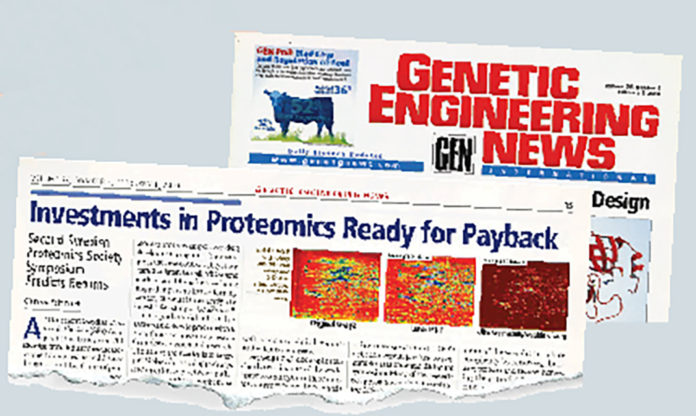Editor’s Note:
The global proteomics market is estimated to increase to $30.6 billion by 2025 from $17.5 billion in 2019, according to a report from Market Data Forecast. The report says that proteomics is the “forensics of living tissue” and that it can improve our understanding of health problems and speed the development of more effective treatments. Factors driving growth in the proteomics market include the need for customized therapies, the application of new technologies, and the availability of funding for proteomics research. The field has come a long way since the publication of the article below from the February 1, 2004 issue of GEN, which reported on some of the early proteomics approaches along with some of the key players.
At the recent Swedish Proteomics Society (SPS) Symposium in Lund, over 200 international scientists from industry and academia met to hear results and discuss thoughts about the future of proteomics.
Applied Biosystems actively supported the symposium, as well as SWEGENE (a consortium for functional genomics research established by the Chalmers University of Technology, Goteborg University, and Lund University/Lund Institute of Technology), Agilent, Amersham Biosciences, Bruker, ThermoFinnigan, and Waters Micromass.
“Scandinavia already has a strong position internationally in proteomics, and in the future we expect that this will result in more start-up companies that could generate interesting, innovative technologies in proteomics, including improvements in bioinformatics, protein arrays, and nanotechnology solutions for protein analysis,” said Bob Galvin, European business development manager at Applied Biosystems.
Pharma and biotech firms with a strong interest in proteomics were well represented by speakers and delegates from Active Biotech, Ace Biosciences, AstraZeneca, Cellzome, Ferring, NeuroNova, Novartis, and Novo Nordisk.
Jan van Oostrum from Novartis reported that the company’s proteomics program has already resulted in two new drug candidates in clinical development. Additionally seven drug candidates are in the pipeline in preclinical development. Van Oostrum also revealed that in addition to the drug candidates, two biomarkers are now being evaluated in clinical studies.
“I think the potential is there to see an increasing number of proteomics-derived candidates and biomarkers in clinical trials over the coming years,” explained György MarkoVarga, responsible for the proteomics group of AstraZeneca and chairman of the Swedish Proteomics Society. “Today we have a strong proteomics profile to support our drug development programs. One example is the case-control safety study started in Japan this fall, where gene markers and biomarkers are being mapped in patients treated for lung cancer, in what is currently the largest safety study at AstraZeneca.”
Disease-associated research
The speakers did reflect this anticipated development with a great focus on presenting results from disease-associated research. The aim of the studies is to interpret biology by mapping pathways and interference between pathways, to identify biomarkers, and to study clinical response and outcomes in disease.
Although 2D electrophoresis clearly remains one of the workhorse technologies in these studies, improvements in methods using mass spectrometry (MS) were discussed during the symposium. Many of the presented approaches included combining MS detection with pretreatment of the samples to reduce complexity by removing abundant proteins and thereby increasing the potential for detecting concentration differences in less abundant proteins.
Improvements in managing the vast amounts of data generated by these approaches are the basis of a number of young start-up companies in the region. Ludesi has improved 2D data interpretation with its HiQ-iP™ technology. In a study recently presented with the Cancer Centre Karolinska (CCK), Ludesi could find almost 70% more information than the CCK had been able to detect with previously established methods.
“It is impressive that all the information we normally extract was found by Ludesi, plus almost 70% more,” commented Professor Gert Auer, coordinator of the Swedish cancer proteomics project. “If only half of the proteins associated with this information can be identified, this would be a considerable achievement.”
Alphalyse, spun off from Ace Bioscience in 2002, has integrated cutting-edge 2D and MS analysis into automated processing of large numbers of samples to generate data with extensive bioinformatics support. The service is offered to pharma and biotech companies on a CRO basis.
Another company, MDS Denmark, is offering complex proteomics mapping services, with a focus on developing software for advanced data analysis.
Protein array approaches
Protein array approaches were not discussed to any great extent. However, Leigh Anderson, one of the early pioneers in proteomics and founder and CEO of the Plasma Proteome Institute in Washington, DC, did point toward the gap between the technologies used in current proteomics mapping and the needs that must be met to apply the knowledge from this science in clinical research.
To validate biomarkers in samples and include their use in clinical practice, methods need to become suitable for repeated analysis of patient samples with high quality and safety, he said.


